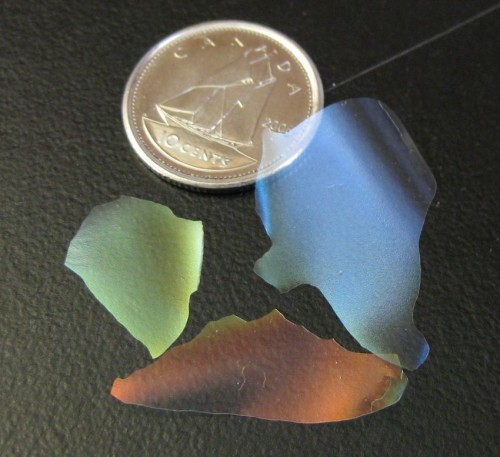Colorful Iridescent Glass Films that Reflect UV and Infrared Light
Nanocrystalline cellulose, a “building block” of wood pulp, is organized in a helical structure similar to a spiral staircase. Silica, a primary component of glass, er … isn’t. Nevertheless, the researchers mixed the two materials together and then burned away the cellulose. Once the smoke cleared from the room and restorative salve had been applied to singed skin, they found themselves confronted with yellow, blue, green, and red glass films punctuated by a large number of pores or holes arranged in a helical structure that … you guessed it – resembled a spiral staircase (Physorg.com).
Image Credit Kevin Shopsowitz
Each hole in the glass film is less than 1/10,000th of the diameter of a human hair, and the presence of the pores in the helix lends the films a wide range of applications. For example, when certain liquids become trapped in the pores the optical properties of the films become altered. According to Shopsowitz, “by functionalizing the pores to make them more selective to particular chemicals, we may be able to develop new sensors that are very sensitive for detecting substances in the environment” (Physorg.com). The films might also find a purpose in the pharmaceutical industry, whose members could use them for various molecule separation activities.
Anyway to recap: the scientists replicated the structure of a biological material (wood) using an inert mineral material (glass) and thereby altered its properties. In so doing they rendered said inert mineral material even more useful to human beings. It should be observed however, that this isn’t the first time silica has assumed the position: the lab-created silica helices mimic the structure and consequently the coloring of the exoskeletons of iridescent beetles.
Image courtesy http://jackphoto.wordpress.com
The films might be used to reduce the energy needed to cool buildings: “windows could be treated with the transparent films that reflect infrared light – the light that heats up a building. Right now, metal particles are often used to do this but they tint the windows brown” (Physorg.com). The optical effects produced by the films in conjunction with liquids might find application in lighting design or wall coverings as well. And in closing, I’d like to point out that they are pretty because they are shiny.
I’m filing iridescent glass film under wood and fire because of how it’s made and because of its properties.
Cited:
“Researchers Create Iridescent Glass that can Reflect UV or Infrared Light.” Physorg.com via the University of British Columbia. 11/17/10. Accessed 11/17/10. URL.


















[…] thinking, “but wait wasn’t there that glass that changes color and then that other really cool irridescent glass film? Hasn’t this been […]
Leave a Wordpress Comment: